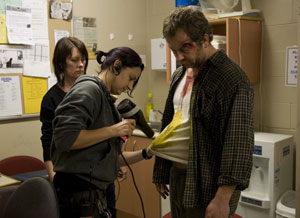Wardrobe Person
Tasks & duties

Wardrobe people may do some or all of the following:
-
discuss costumes and accessories with the production designer and director
-
find or make the costumes and accessories to be worn
-
alter costumes to fit actors
-
clean and repair the costumes
-
may help actors put on difficult costumes
-
work with the director to ensure costumes look as they are supposed to from one scene to the next
-
make sure the costumes look right on the stage under lights
-
may research costumes and the period they come from
-
may design costumes or accessories
-
may make patterns and cut them out
-
may manage the costume budget in a production
Skills & knowledge

Wardrobe people need to have:
-
knowledge of production methods and procedures for television, film and theatre
-
the ability to break down a script and visualise each scene
-
knowledge of fabrics including how they behave under lights, their durability, and how to dye fabrics
-
knowledge of the history of fashion
-
knowledge of colours and shapes and how they look on a stage or set
-
good measuring, pattern-making, cutting and sewing skills
-
design and planning skills
-
problem-solving skills
-
the ability to follow instructions
-
time-management skills to work to deadlines and schedules
Many wardrobe people are self-employed so they need to have business skills, computer skills, and the ability to negotiate contracts with employers, and get sponsorship from other organisations. They may have to drive heavy vehicles.
Entry requirements
There are no specific entry requirements to become a wardrobe person, however a clothing, design or textile course is preferred by some employers.
Secondary education
Sewing and art may be useful secondary subjects.
Training on the job
Wardrobe people gain skills on the job.
Useful experience
Experience in the clothing industry, backstage work in film, television or theatre, or any craft, sewing or tailoring experience are all useful for wardrobe people. It may also be helpful to have experience running a small business, as most wardrobe people are self-employed. Jobs that involve working with people may also be helpful.
Related courses
Drama and Theatre Studies
Graphic Arts and Design Studies
For more information, please refer to Career Services.
Document Actions
